Tomatoes and aubergine young plants from Lubera Edibles®. We can already see the incredulous amazement in the eyes of many of our customers. And that's why we start early enough to explain what we do at Lubera Edibles vegetable-wise. Because one thing is certain: plant producers as well as young plant producers will have to position themselves more broadly and pragmatically in the future in order to resist the distortions of the market.
Young plants of vegetables at Lubera Edibles
In addition to fruit and berries, vegetables are to become the third mainstay of the Lubera Edibles young plant programme. This is only logical: if our love of young plants goes through the stomach, then vegetables are an absolute must. Ultimately, we are trying to develop three different groups of vegetable plants:
- Everlasting Vegetables Everveg®: this programme consists of perennial vegetables, most of which are known only to rhubarb and asparagus growers, but which are extremely diverse. Lubera Edibles is constantly expanding its product range here, and a broad range of young plants will be available as early as spring 2020.
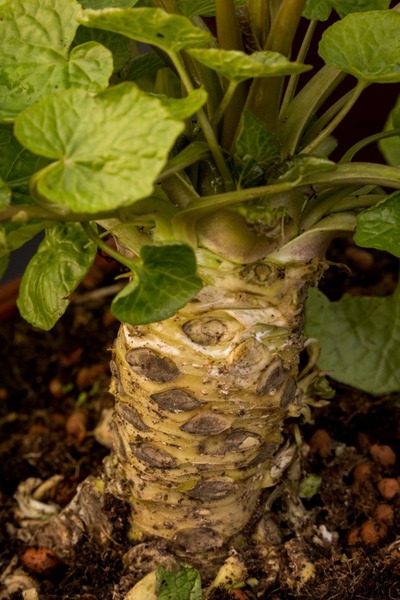
Picture: Wasabi plant
- Root vegetables Fruits of the Roots: here we offer young plants from root vegetables, which as a rule can only be cultivated for one year. Here, too, the first young plants are available for next spring.
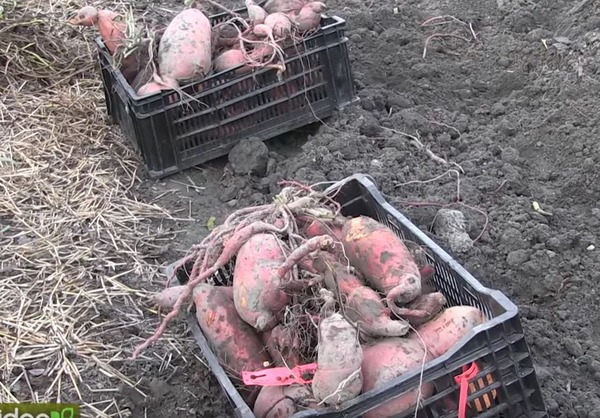
Picture: sweetpotatos direct after harvest
- Tomatoes, aubergines, goldenberries/groundcherries – vegetables from the Solanaceae family: here we are mainly looking for varieties that can be grown outdoors without protection and with the highest possible yield.
In the next gardener’s letter we will present the range of young plants for 2020 in more detail.
The most important vegetable...
is probably the tomato. And so it is of course also strategically justified that we take care of the beautiful tomatoes in a very large breeding programme (in 2019 e.g. 2500 seedlings and a total of over 3000 fruiting tomato plants). Now you can say for sure that it is a bit crazy to take care of the same kind of vegetables in which huge corporations with hundreds of growers are involved. But here, too, the same thing can be noticed as with most fruit and berry species: all major breeding programmes are first and foremost concerned with commercial cultivation – and the home garden tomatoes are more a kind of waste and second use product. Ultimately, the focus on the garden and thus also the technical answer to the specific questions and problems of gardening are often missing.
Breeding goals for tomatoes: “Topless” outdoor tomatoes
A few years ago, when I was able to visit the breeding fields of Culinaris and its breeding programme in cooperation with the University of Göttingen, I was impressed by the outdoor tomato trials. That was exactly what I had been waiting for: tomatoes that grow without any protection, without roofing (i.e. topless) in our climate north of the Alps, in Central Europe, tomatoes that bear fruit. It is our breeding goal to strengthen and enrich these resistances, and above all to increase the variety of outdoor tomatoes (colours, sizes, patterns) and to further improve the taste experience. We do not make any compromises. In our trial fields the tomatoes are 30 cm apart, they touch each other, diseases can spread very quickly and thanks to our climate in Buchs, Switzerland with 1300 mm rainfall (half of it in the summer) there is always enough humidity to intensify the spread of diseases. In our breeding work, only that what survives this endurance test will progress.
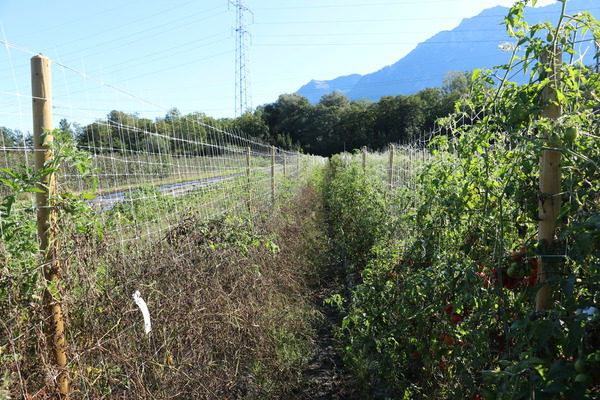
Picture: infront of the left side currant tomato (wild species from Peru), on the right side a resistant plant of a new breeding line
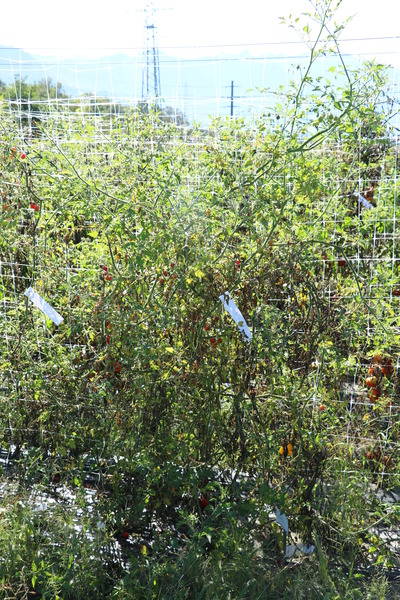
Picture: typical picture of a very healthy garden tomato without a rain cover in mid September

Picture: at the beginning of the row varieties with completely dead plants, in the middle of the row much healthier plants
A few numbers might help to understand this focus even better: from 2500 planted genotypes (all of which have at least one parent with resistances) we have selected about 400 genotypes from mid-August until the final selection in mid-September. Of these, about 100 breeding lines will emerge, from which we hope to gain extremely resistant varieties. We will use about 100 genotypes for further breeding because they have interesting shapes and colours and growth types, but may not be resistant enough. And the remaining 200 selections will be sorted out in the winter on the basis of data analysis because they are not interesting enough, because we have better siblings or because brand-supported gene analysis has shown that resistance is insufficient (or is not suitable for further breeding).
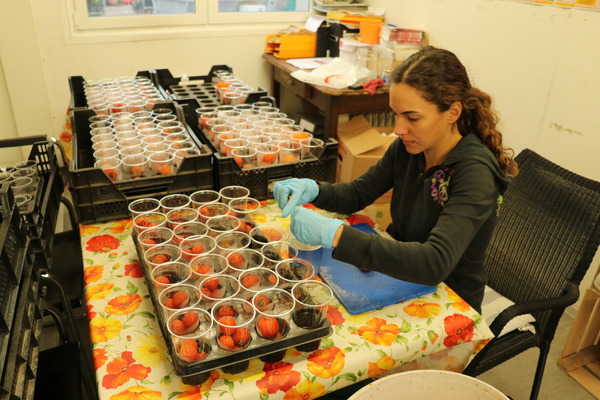
Picture: fruits of selected genotypes

Picture: gather seeds
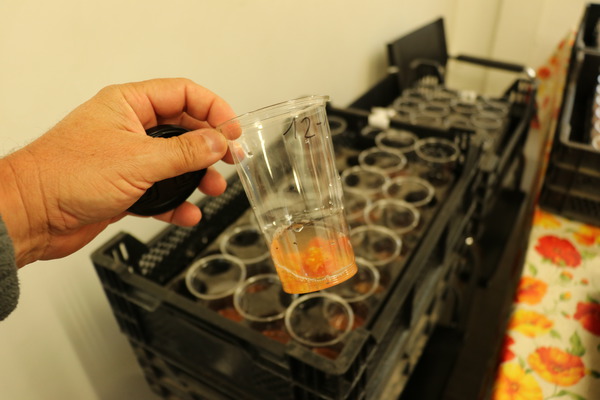
Picture: seed samples are filled with some water and kept until water and seeds separate
Goals for breeding aubergines: early ripening outdoor aubergines in all colours and shapes
It is also important to us to further develop the aubergine in our vegetable programme. The aubergine is in line with the trend of the times: it can be used as a pasta substitute (food with less carbohydrates) and in a certain way it is also a vegetable that can substitute meat in vegetarian cuisine. Obviously, aubergine is a trendy vegetable, but there are only a few outdoor varieties on the market that give us a large enough harvest during the short growing season. Also the possible diversity of small and large, round and elongated, red, blue, black, white and green varieties is hardly shown. In addition, similar to the sister vegetable tomato, aubergines also have an incredibly high ornamental value. First the beautiful flowers and then later in August the coloured fruits are extremely attractive. Now we could watch the entire autumn, how the passers-by stopped on their walk at the edge of our breeding field and admired our aubergines in all colours. Most of the time it was not only the visual impression but also the question what it was that they saw...from a new berry variety to apple-hard tomatoes and small pumpkins – all hypotheses were expressed. This shows how little aubergines are known in all their forms (except blue and black). Here the garden market can certainly be expanded considerably because social trends such as “less meat” also speak in favour of this type of vegetable, in addition to the attractiveness of the assortment. The healthy, Mediterranean cuisine (Aubergine slices from the oven or from the grill, with some olive oil) also continues to be trendy, and the ornamental value of the extremely easy-to-cultivate outdoor aubergines can likewise still be discovered.
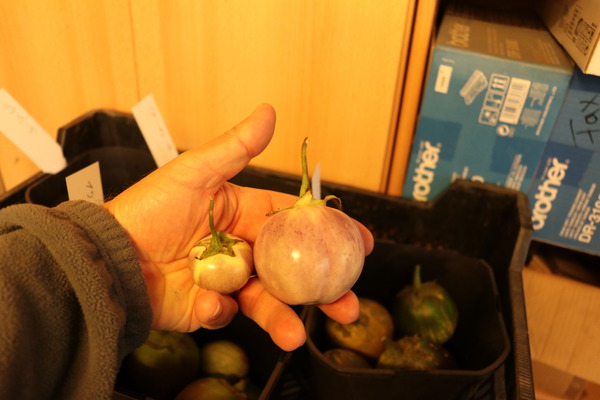
Picture: small asian aubergine and a bigger selection from our own breeding
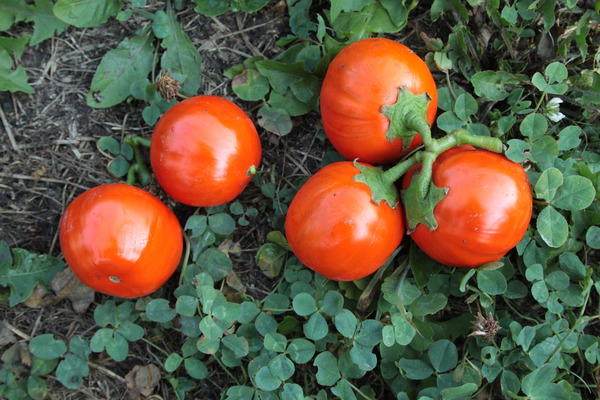
Picture: red-orange aubergines
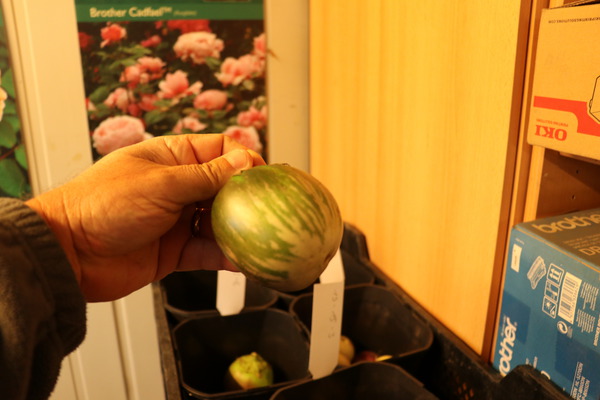
Picture: new striped aubergine selection
Vegetative propagation
Of course, we are also planning to align our young plant production with the core competencies of Lubera Edibles: for example, we are planning with vegetatively propagated young plants and have already carried out corresponding trials this year.
Bild Testpflanzen ex vitro von tomaten,wenn du hast, jeweils dran denken bei neuen Produkten
This sounds unusual at first glance, but it could prove to be very promising. Here are the advantages of vegetative propagation from a breeding point of view:
- We do not need 8-9 selfing generations to produce open-pollinated varieties or even F1 hybrids.
- This frees up capacity so that we can make many more crosses per year in order to improve resistance, variety
and flavour and to expand the range very quickly.
- In vitro propagated young plants can also be very promising from the producer's point of view: they have a very uniform quality, are extremely juvenile and vigorous. In combination with the resistance and vigour of the varieties, the new outdoor tomatoes can replace the grafted varieties.
When will we be on the market with young plants of tomatoes and aubergines?
Well, of course the breeder's view goes into the future – and breeders always look very far into the future...Nevertheless, after the current trial and breeding year we can see that it is quite realistic that we will offer the first young tomato plants in spring 2022 or 2023. By the way, this is a very short time for a breeder who started breeding new apple varieties 30 years ago...
Conclusion
Here is something else: don't believe that apples and tomatoes are so different; in our breeding programme with the tomatoes we use various breeding methods, which we have learned with the apple. Perhaps it is because of this similarity between berries and fruits and fruit vegetables that we still don't know exactly what really tempted Eva: was it a fig, a pomegranate, an apple or maybe a tomato? Lubera and Lubera Edibles are there in any case...
